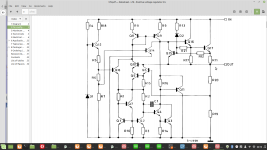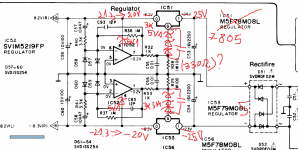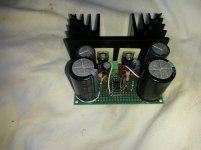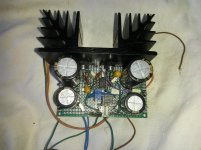I think the word you were looking for was "imagine" not "conclude", it would have saved a bit of time 😉Let's conclude that the scope is a new digital model, and the bottom line of the DC readings show a virtual straight line with perhaps a nanovolt of interference, likely from external sources.
And I'm sure a lousy nanovolt isn't enough to even discuss or worry about.
"78/79xx has no divider at the output,it is referenced to ground...the divider is internal, can't be disabled or modified.it's lm317/337/lt1083...86 that has it. "
R17/R11 / R20+R19 I think suggests otherwise in the schematic of a 78xx
whereas D2 + D3 which are zeners in a 317 complicate its output being classed as a divider
rather it has zeners biased by internal resistance as shunt regulation
R17/R11 / R20+R19 I think suggests otherwise in the schematic of a 78xx
whereas D2 + D3 which are zeners in a 317 complicate its output being classed as a divider
rather it has zeners biased by internal resistance as shunt regulation
Attachments
Could you possibly help me with commenting my idea if there's anything wrong with it? I already built one regulator like this for +-10v supply rails for a headphones amp.
As i need to supply a phono preamp too, I thought of trying to modify the Technics regulators so that i get the best noise and regulation for +-20v suply rails too .
Using the lowest voltage 78/79xx regulators(using lm340 either MCT 78xx and mc79xx if their datasheet are true to the last bit)
???? https://www.diyaudio.com/forums/power-supplies/359652-fine-ic-voltage-regulators-14.html#post6335583
and a series of zenner diodes to get to the voltage i want , i should get the lowest noise and best ripple rejection.
I don't really know the zenner noise though...i can only shunt them with a 100nf...10uf capacitor.
Also the 100ohms resistor used to apply the current feedback to the regulator should probably be raised to 330...470ohms to be more efective which will raise the output even more by about 1.2...1.5v , thus i'd have a +-21.3v voltage regulator, ideal for my last phono preamp.
Using 3 zenner diodes in series i should also lower some of their counterphase noise too.
I can replace the 5v1 zener resistors with 4v7 variation to get the output voltage to +-20v as the thermal variation in 4v7 is very close to 5v1 zenner one.
The aditional op-amp improves the ripple rejection by at least 20db as i read in a very old article on those technics cd players using this kind of regulator .OPA2227 comes to mind as op-amp.
Using the 7805/7905 and three 5v1 zenners as refference with a 330ohm feedback resistor lowers the output headroomin case of a bigger surge i think...that might be the only downside in my view now, but i'm just focusing on reducing the noise and ripple for the moment as the circuits involved don't take too much current.
I am thinking of supplying also the +-10v regulator with the +-20v regulator and maybe no big value capacitor should be used at the +-20v reg output for that matter.
One more thing, consulting the actual datasheet from Philips and Vishay for BZX 55c series , the lowest tempco zenners are the 5.1v and 4v7 zenner , not the 6v(6v2) ones as the Art of Electronics said.
As i need to supply a phono preamp too, I thought of trying to modify the Technics regulators so that i get the best noise and regulation for +-20v suply rails too .
Using the lowest voltage 78/79xx regulators(using lm340 either MCT 78xx and mc79xx if their datasheet are true to the last bit)
???? https://www.diyaudio.com/forums/power-supplies/359652-fine-ic-voltage-regulators-14.html#post6335583
and a series of zenner diodes to get to the voltage i want , i should get the lowest noise and best ripple rejection.
I don't really know the zenner noise though...i can only shunt them with a 100nf...10uf capacitor.
Also the 100ohms resistor used to apply the current feedback to the regulator should probably be raised to 330...470ohms to be more efective which will raise the output even more by about 1.2...1.5v , thus i'd have a +-21.3v voltage regulator, ideal for my last phono preamp.
Using 3 zenner diodes in series i should also lower some of their counterphase noise too.
I can replace the 5v1 zener resistors with 4v7 variation to get the output voltage to +-20v as the thermal variation in 4v7 is very close to 5v1 zenner one.
The aditional op-amp improves the ripple rejection by at least 20db as i read in a very old article on those technics cd players using this kind of regulator .OPA2227 comes to mind as op-amp.
Using the 7805/7905 and three 5v1 zenners as refference with a 330ohm feedback resistor lowers the output headroomin case of a bigger surge i think...that might be the only downside in my view now, but i'm just focusing on reducing the noise and ripple for the moment as the circuits involved don't take too much current.
I am thinking of supplying also the +-10v regulator with the +-20v regulator and maybe no big value capacitor should be used at the +-20v reg output for that matter.
One more thing, consulting the actual datasheet from Philips and Vishay for BZX 55c series , the lowest tempco zenners are the 5.1v and 4v7 zenner , not the 6v(6v2) ones as the Art of Electronics said.
Attachments
Last edited:
Marcel,
You wrote:
But that is very much misleading, the lt3042 (and relatives) are used with heavy filtering on that reference.
What counts is the end result:
Effectively 2nV (E-9V) /sqrtHz across from say, 100Hz up to 1MHz (the effective operating range)
Also, it is independent of output voltage!
Compare this to the 200nV /sqrtHz of a !! Filtered LM317..
You wrote:
Maybe You are talking about the raw current noise of the 100uA reference here?LT3042 (unknown, presumably bandgap): 6 nA from 10 Hz to 100 kHz at 100 uA, so 189.7E-9 Iref/sqrt(Hz)
But that is very much misleading, the lt3042 (and relatives) are used with heavy filtering on that reference.
What counts is the end result:
Effectively 2nV (E-9V) /sqrtHz across from say, 100Hz up to 1MHz (the effective operating range)
Also, it is independent of output voltage!
Compare this to the 200nV /sqrtHz of a !! Filtered LM317..
Just realized that the MCT78xx datasheet writes the noise as uv/v so it's normal to be constant...and thus the mct series is actually noiser than many others.
So the best combination for my variation of Technics regulator would be LM340-15 plus one 5v1 zener and MC7905 plus 3x 5v1 zenners, but for convinience with a a sacrifice of 45uv of noise and 5db of ripple rejection loss(hopefully compensated by the op-amp) a 7915 plus 5v1 zenner will probably be ok.
So the best combination for my variation of Technics regulator would be LM340-15 plus one 5v1 zener and MC7905 plus 3x 5v1 zenners, but for convinience with a a sacrifice of 45uv of noise and 5db of ripple rejection loss(hopefully compensated by the op-amp) a 7915 plus 5v1 zenner will probably be ok.
Last edited:
Marcel,
You wrote:
Maybe You are talking about the raw current noise of the 100uA reference here?
But that is very much misleading, the lt3042 (and relatives) are used with heavy filtering on that reference.
What counts is the end result:
Effectively 2nV (E-9V) /sqrtHz across from say, 100Hz up to 1MHz (the effective operating range)
Also, it is independent of output voltage!
Compare this to the 200nV /sqrtHz of a !! Filtered LM317..
I am indeed comparing the references, and the advantage of the LT3042 is indeed that it is simple to put a filter between the reference and the rest, as I wrote here:
https://www.diyaudio.com/forums/power-supplies/359652-fine-ic-voltage-regulators-4.html#post6329769
https://www.diyaudio.com/forums/power-supplies/359652-fine-ic-voltage-regulators-6.html#post6330100
Could you possibly help me with commenting my idea if there's anything wrong with it? I already built one regulator like this for +-10v supply rails for a headphones amp.
It is 78Xx/79XX with noise reduction. Elve designed noise reduction for LM317/337 using transistor here. You can search it.
Just realized that the MCT78xx datasheet writes the noise as uv/v so it's normal to be constant...and thus the mct series is actually noiser than many others.
So the best combination for my variation of Technics regulator would be LM340-15 plus one 5v1 zener and MC7905 plus 3x 5v1 zenners, but for convinience with a a sacrifice of 45uv of noise and 5db of ripple rejection loss(hopefully compensated by the op-amp) a 7915 plus 5v1 zenner will probably be ok.
6x LM329 might be better, and do away with the 78xx, 79xx , and instead a suitable transistor as a pass device for each rail. https://www.analog.com/media/en/technical-documentation/data-sheets/129329fd.pdf,
Or if layout demands the 78xx 79xx remain, then 2x LM329 as a stack on each , there should be enough current in the grounding pin of each 78xx 79xx to bias the LM329 precision zeners on. Should give 18.8v - if that will do.
i know...everybody is sending me again and again to elvee's regulator...i stick with the Technics as it looks more promissing and is also taking less space for two regulators.Here's the +-10v regulator for my headphone's amp.Not yet connected...Looking first for building the second +-20v regulator for the phono preamp then hooking them up in series...so the headphone's amp regulator will load the phono preamp regulator too...I'll just see which one is better, the Kenwood regulator or this new one.It is 78Xx/79XX with noise reduction. Elve designed noise reduction for LM317/337 using transistor here. You can search it.
Attachments
Last edited:
6x LM329 might be better, and do away with the 78xx, 79xx , and instead a suitable transistor as a pass device for each rail. https://www.analog.com/media/en/technical-documentation/data-sheets/129329fd.pdf,
Or if layout demands the 78xx 79xx remain, then 2x LM329 as a stack on each , there should be enough current in the grounding pin of each 78xx 79xx to bias the LM329 precision zeners on. Should give 18.8v - if that will do.
I already built a +-20v regulator based on a Kenwood schematic based on op-amp transistor and zenners...i just want to check the Technics variation too. Lm329 has 100uv of noise by itself...i still have no idea what a bzx 55c zenner diode noise would be compared to a regulated zenner.I don't need overcomplications.
Attachments
The magic component that makes #150 a low noise dual tracking regulator, is R165. If IC5 happens to be a JFET- or MOSFET-input opamp, additional good performance is available by changing component values. (datasheet)
what i don't like at technics regulator is that it's not a tracking one like kenwood...but all my toys are capacitor coupled so safe enough.
Various posts speak of power supply noise. What kind of noise is this? If it is natural noise like statistical noise voltages generated as a result of slightly non-uniform electron distributions in conductive materials, that is a property of materials used. How can, for instance, copper, aluminium and silicon have noise levels lower than what their physics dictates?
Added Later:
I think, the issue has more to do with power line interference signals and power supply ripple. The latter is inevitable when power is delivered by the mains supply and interference signals may be too diverse to completely block, especially, in sub average neighbourhoods.
Added Later:
I think, the issue has more to do with power line interference signals and power supply ripple. The latter is inevitable when power is delivered by the mains supply and interference signals may be too diverse to completely block, especially, in sub average neighbourhoods.
Last edited:
Linear PSU noise comes in 3 flavors.
Hum at 120Hz or 100 Hz from the unregulated ripple that is not perfectly suppressed by the regulator. This goes up with current draw.
Thermal noise from all resistive materials. This is a white noise, flat at mid and high frequencies. This goes up with high value resistors.
Flicker noise from all semiconductor junctions. This is the 1/f noise at low frequencies. High raising under 100Hz. This goes up with low current going through junctions.
Other noise issues are RF pickup, pour grounding, may be more.
Hum at 120Hz or 100 Hz from the unregulated ripple that is not perfectly suppressed by the regulator. This goes up with current draw.
Thermal noise from all resistive materials. This is a white noise, flat at mid and high frequencies. This goes up with high value resistors.
Flicker noise from all semiconductor junctions. This is the 1/f noise at low frequencies. High raising under 100Hz. This goes up with low current going through junctions.
Other noise issues are RF pickup, pour grounding, may be more.
Shot noise from semiconductor junctions giving white noise.
1/f noise from resistors whose resistance varies with time, becomes noticeable when there is a current flowing through them.
1/f noise from resistors whose resistance varies with time, becomes noticeable when there is a current flowing through them.
I wonder why i never get answers for the questions i really want to be answered.Writing here it feels like talking to God...
I read you, can you repeat your questions ?I wonder why i never get answers for the questions i really want to be answered.Writing here it feels like talking to God...
God.
@mchambin
it was this post what i was talking about:
https://www.diyaudio.com/forums/power-supplies/359652-fine-ic-voltage-regulators-15.html#post6335611
it was this post what i was talking about:
https://www.diyaudio.com/forums/power-supplies/359652-fine-ic-voltage-regulators-15.html#post6335611
what i don't like at technics regulator is that it's not a tracking one like kenwood...
I do not know if that was a question.
Why do you think you need tracking regulators? Your in/outs should reference local "zero", NOT "half the difference between the supplies".
Tracking is convenient for highly adjustable supplies. It also avoids one voltage reference. Unless otherwise specified, it does not ensure both rails collapse if one does.
- Home
- Amplifiers
- Power Supplies
- Are you really fine with IC voltage regulators ?




